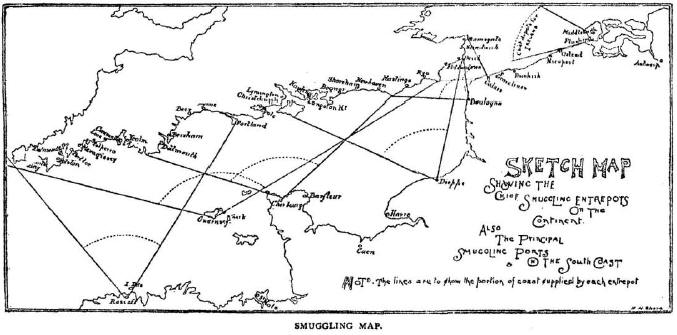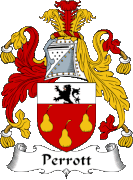A Smuggling Tale
By Ruth Draycott.
My husband Anthony’s Perrett ancestors knew all about smuggling, mainly from the lawful side – but then there was Maria; more of whom later!
In 1711 Anthony’s 6 x great grandfather John Perrett married Jane Loud in Stoke Gabriel, a village on the River Dart. With the road network being so poor and living in a waterside village, transport for goods and people by boat was an essential part of life and so, many villagers learned to handle a boat from a young age, later following water-borne occupations. The Perrett family certainly did and Anthony’s 4 x great grandfather, Richard (1) Perrett (b Stoke Gabriel 1762, d Newton Ferrers 1833) became a mariner moving downriver to Dartmouth, where, in 1788, he married Elizabeth Cole at Townstal St Clement before settling in the Brixham/Kingswear area.
Richard (1) and Elizabeth produced 8 children. Three of the boys – Samuel (b 1789 Brixham), Richard (2) (b 1797 Kingswear) and Henry Nathaniel (b 1807 Kingswear) all followed their father into the Navy and then the Preventive Boat Service (later reformed as the Coast Guard). Although originally established as part of the defence structure, these bodies were also tasked with saving lives at sea and deterring smuggling by seizing waterborne cargoes of the ‘Free Traders’.
The River Yealm in Devon, which opens into Plymouth Sound, was a noted smuggling hotspot, with easy access to the Channel Islands and France. Coast Guard records show that, at least from 1817, Richard (1) was posted to Newton Ferrers/Noss Mayo serving as Chief Officer of the Yealm Preventive Boat with Samuel serving as a Commissioned Boatman. In 1812, at Brixham, Samuel had married Sarah Ashford and they produced at least five daughters – Maria (1812), Elizabeth Ashford (1814), Sarah (1816), Louisa (1818) and Matilda (1820). Thus both families moved to Newton/Noss.
1822 was a watershed moment for the Preventive Boat Service as it was reorganised into H.M. Coast Guard. Richard (1) retired in 1823 on a pension and died in 1833 at Newton Ferrers, where he is buried. Samuel was sent to Ireland in 1822 and remained there, serving at various stations until 1850 when he was posted to Rattery Head, Aberdeen and from thence to Buckie, Banff in 1851 when he retired on a pension of £40 p.a. due to ill health.
Samuel’s brother Richard (2) had also served as a ‘Seaman on the Yealm Preventive Boat’ and he too was posted to Ireland in 1821, after marrying by licence Philippa Kingcombe in Noss Mayo (Revelstoke). Richard (2) and Philippa had a total of five children – Richard (3) (1824), Jane (1828), John (1830), George Henry (1832) and Elizabeth (1835). Richard (2) moved around Ireland to various postings until 1832, when he was sent to Burnham Overy Staithe in Norfolk and afterwards to Poole. He was then returned to Ireland, to Waterford/Dunmore East, where he died in 1838. Philippa and her children returned to her home village of Noss Mayo, where she enjoyed the support of her family. Local census returns show that she ran the village shop until her death in 1886. Her second son, John Perrett (1830-1915), joined the Navy and later became Chief Coastguard at New Quay, Cardigan.
The large Kingcombe/Kingcome family was well—established in Newton/Noss and although Philppa’s branch of the family appears to have been law-abiding, the same cannot be said of some of her Kingcome cousins! When Philippa’s brother-in-law Samuel Perrett was posted to Ireland, it seems that his daughter Maria remained in Devon, possibly staying with her grandparents Richard (1) and Elizabeth. Her grandfather died in September 1833 and a few weeks later, in November, Maria married Philip Brown Kingcome at Stoke Damerel church. Philip was a fisherman from Noss Mayo – pilchard fishing was a lucrative source of income for the local villagers – however he was also heavily involved in smuggling! One of Philip’s brothers, Richard ‘Kingcup’ Kingcome, enlisted as a Coast Guard and served at a number of Cornish stations before the temptation of smuggling profits became too much and he left the service to open a pub, the Crown and Anchor, on the quay in Fowey. The book ‘Smugglers of Fowey’ written by Henry Shore, a former Naval Commander and Coast Guard, devotes a whole chapter to Richard’s exploits and also gives dishonourable mention to Philip ‘Kingcup’, Maria’s husband!

Not all of Maria’s Kingcome brothers-in-law, however, were free traders. One of Philip and Richard’s older brothers, John Kingcome, was beyond reproach, serving in the Royal Navy and, at one time, serving as a Coast Guard Commander (wisely being posted to Suffolk!). He ended his career as an Admiral!
Philip and Maria produced two children, William (1834-1870) and Louise (1838-1849?) but poor Maria’s marriage was to be short-lived. She was widowed in November 1838, the year of the big storm.
In Plymouth and West Devon Record Office is a transcript of ‘Evens Diary’, written by the local tailor and occasional smuggler. It gives a fascinating account of life in the area at this time. His entry for 28th November 1838 reads:
“Heard part of James Chinowath’s cargo washing ashore, being a great storm in which Jn. Reeves’ cargo was all lost and several vessels wrecked – the Eliza of Cawsand and cargo lost. Philip Kingcome, Wm Jenkins, T. Langdon and James Hardy drowned”.
Commander Shore suggests that Philip had been to buy brandy at Roscoff and the boat was wrecked on the Mew Stone on the return trip, the wreckage being washing into Hope Cove with barrels still attached. Philip’s body was never recovered.
Maria moved in with her widowed grandmother, Elizabeth, who died in 1842. The Noss Mayo census returns state that Maria worked as a schoolmistress and subsequently as a needlewoman, before remarrying in 1864 – yes, to another Kingcome cousin, John, but this time he was a carpenter and a member of a different branch of the family! Later census returns show John and Maria, happily settled in their own cottage with John continuing to work as a carpenter. In 1891 Maria’s cousin, the widowed Mary Bunker (nee Perrett) and three of her family moved in with them. Mary was the daughter of Henry Nathaniel Perrett, the brother of Maria’s father, Samuel. Henry Nathaniel (1807-1872) was a Coast Guard who had served at postings in Kent and Suffolk before returning to Noss on his retirement. He and his wife Elizabeth (nee Knight, 1804-1866) are buried in Newton Ferrers churchyard.
Maria and Philip’s son, William, became a Merchant Navy Captain and he married Miriam, another of the Kingcome cousins. An impressive wall plaque at the old Revelstoke church records that Miriam (b 1839) died aged 27 on the ‘Sorabjee Jamsetjee Jee Jee Buoy’ in India. William died three years later of a broken heart.
Having outlived both of her children, Maria died in 1892 at the age of 80.
